ISSN 2410-5708 / e-ISSN 2313-7215
Year 7 | No. 20 | p. 130 - p. 147 | october 2018 - january 2019
© Copyright (2018). National Autonomous University of Nicaragua, Managua.
This document is under aCreative Commons
Attribution-NonCommercial-NoDerivs 4.0 International licence.
Effects of water quality and soft-substrate on benthic macrofauna in the intertidal zone of Pochomil beach, San Rafael del Sur
Submitted on August 26th, 2019 / Accepted on September 28th, 2019
https://doi.org/10.5377/torreon.v7i20.8567
MSc. María Joaquina Ibarra-Arana
MSc. on Aquaculture Administration and Technology
National Taiwan Ocean University (NTOU), Keelung City 202, Taiwan
mariajoaquinaibarra@gmail.com
PhD. Lester Rocha
Phd. on Biology. Animal Science Faculty
Universidad Nacional Agraria, Managua
Keywords: Benthic macrofauna, intertidal zone, Pacific Ocean, soft substrate
Abstract
A spatial and temporal study of the benthic macrofauna was carried out in the intertidal zone of Playa Pochomil, Nicaragua, in three sites called S.A (sandy site), SRR (rocky site with river) and S.R (rocky site), respectively. At the end of the study, a total of 596 individuals belonging to four Edges (Mollusca, Annelida, Arthropoda and Echinodermata) were counted. Benthic macrofauna diversity calculated using the Shannon-Weaver index reflects very low diversity values during all sampling periods. Through the Jaccard and Morisita-Horn index, it was evidenced that there was low species similarity. In addition, it was found that the temporality had no significant direct effect on the abundance and distribution of the benthic macrofauna, but that it was mainly influenced by the physical characteristics of the sampling sites.
1. Introduction
The coastal zone is the part of the land affected by its proximity to the ocean and that part of the ocean affected by its proximity to the land; One of the characteristics of this area is the great natural productivity of the ecosystems that compose it, which is especially true for tropical systems, where the Central American region is located (Rodríguez and Windevoxhel, 1993). In turn, Tait (1971) defines the intertidal zone as the space between high tide and lower and is a strip affected by the sweeping of waves and tides, subject to periodic dives and emersions.
Due to the intense human activity, many of the modifications that this area undergoes have an anthropic origin and because of their potential to generate cumulative reactions, they tend to be the most harmful for the environment (Rodríguez and Windevoxhel, 1993). Macro-zoobentonic communities can be considered as indicators of intervened areas of anthropogenic origin or contaminated by organic matter (Villamar, 2013) because being very sensitive and low mobility species, they have immediate responses to changes that occur in the ecosystem (Monserrate et al., 2011).
Biological interactions within a benthic community according to Escrivá (2013) are subject to the dynamism of the sandy beaches which depends to a greater extent on the physical characteristics of the site. According to Gage (2001), the macrofauna is the most taxonomically diverse section of the bentos and most of the invertebrates that inhabit the sandy beaches belong to that last category (Escrivá, 2013). The Annelid Edge (Polychaete Class), Arthropoda Edge (Subfilo Crustacea), Equinodermata Edge and Molusca Edge may be present in the intertidal zone (Molina and Vargas, 1994; Tarazona et al., 1986; Villalaz et al., 2002) . Some of the benthic marine communities have, among other characteristics, that of associating with particular substrates, through morphological and physiological adaptations (Méndez et al., 1985).
Therefore, this research work aims to know the effect of water quality and soft substrate on the benthic macrofauna of the intertidal zone at Pochomil Beach, located in the municipality of San Rafael del Sur, on the Pacific coast from Nicaragua. The community structure of benthic macrofauna in the area was studied and diversity indices were applied which, related to physical-chemical parameters of seawater, granulometry and organic matter of soft sediment, allowed to know the spatial and temporal distribution of the species; All these elements were combined to determine the conditions to which the benthic macrofauna community studied is adapted and to increase knowledge about these individuals and their fundamental role in the ecosystem.
2. Methods and Materials
2.1. Study area
The study area includes the intertidal zone of Pochomil Beach located on the Pacific Ocean coast of Nicaragua, municipality of San Rafael del Sur, Department of Managua (11°46’5.52” N 86°30’6.12” W). The climate of the municipality is Sabana Tropical warm and dry because it is located in a coastal area with temperatures between 27.5 °C and 28 °C, being able to experience periods with a higher temperature especially in the dry season (INIFOM, s.f).
2.2. Population and sample
The study population was represented by all individuals of the benthic macrofauna of soft substrates present in the intertidal zone of Pochomil Beach along 3,295 linear km of coastline. The study sample was represented by individuals with soft substrate benthic macrofauna from the intertidal zone collected in three sampling stations of one square meter each.
2.3. Selection criteria for sampling sites
With the intention of obtaining samples of dissimilar ecological niches, those sites were identified where the interaction of the sea with various types of substrate and / or bodies of fresh water along the intertidal zone of the study site was notorious. The method used for the observation wasin situfor the identification of the intertidal zone and the subsequent selection at the convenience of the sampling points, whose characteristics were the following: Sitio Arenoso (SA): Area exclusively of soft (sandy) substrate, fully discovered and without any protection by vegetation or patches of rocky substrates; the breaking of the waves had direct action on the site at high tide. Rocky Site with River (S.R.R): Its main feature was to have patches of rocky substrate dispersed in the subtidal zone that in turn were surrounded by sandy substrate, the latter extended to the intertidal and supra-tidal areas; the sandy substrate of the two aforementioned areas suffered from the direct impact of the waves at high tide, but the rocky patches reduced their speed to some extent. Rocky Site (SR): In the North zone of the coastal line of the Pochomil Beach, a quite extensive rocky system was projected in the subtidal zone that projected from South to North until reaching the Masachapa Beach, which could protect the individuals from the upper area of the beach and create an ideal environment for species.
2.4. Sample for diversity analysis of benthic macrofauna
Following the methodology used by Brusca (1973), a metal frame of one square meter divided into nine sections of 30 x 30 cm (900 cm2)was introduced at a depth of 15 cm. The sub-samples of benthic macrofauna were extracted from three of the nine sections of the frame. After the sample was extracted, the content was deposited in an individual plastic bag and 95% alcohol was added to preserve them. All samples analyzed at the Aquatic Resources Research Center of Nicaragua (CIRA-UNAN) for analysis according to the Standard Operating Procedures of the Hydrobiology Laboratory that comply with the procedures of the Standard Methods for the Examination of Water and Wastewater (1999).
A 200 µm sieve was used that allowed to retain the organisms of the macrofauna contained in the samples. All individuals were deposited in labeled bottles and the sample was preserved with 95% alcohol. Taxonomic identification up to the level of gender or species of the collected individuals was carried out by means of a stereoscope and a microscope with the support of available literature.
To estimate macrofauna diversity, the Simpson index (1949) and the Shannon-Weaver index (1949) were used.
The Simpson Index (1949):

Where:
pi = proportional abundance of species i, that is, the number of individuals of species i divided by the total number of individuals in the sample.
The Shannon-Weaver Index (1949)

To calculate the precision in the estimation of the Shannon-Weaver index (1949), the following formula was used:

2.5. Physical-chemical parameters of water
The determination of pH, electrical conductivity, salinity, dissolved oxygen and oxygen saturation percentage was performed with field equipment to obtain datain situ. The Biological Oxygen Demand (BOD5), Chemical Oxygen Demand (COD), granulometry and organic matter content analyzes were performed directly in the laboratory
2.6. Spatio-temporal distribution patterns
The Jaccard index (1908) and the Morisita-Horn index were used to measure the degree of similarity or dissimilarity between sampling sites. Through these indexes a qualitative and quantitative comparison with the obtained values could be established.
Jaccard Index:

Where:
a = number of species present at site A
b = number of species present at site B
c = number of species present in both sites A and B
Morisita-Horn Index:

Where:
ani = number of individuals of the i-th species on site A
bnj = number of individuals of the j-th species at site B
da = _ani² / aN²
db = _bnj² / bN²
2.7. Statistical analysis
Diversity indexes were calculated in Past3 software (Hammer et al., 2015). The space-time distribution map was generated with the Surfer 9 software (Golden Software®, 2016). The lme4 package (Bates et al., 2015) was used to adjust the generalized mixed linear model (GLMM) in order to analyze non-normal data when there are random effects, and the Vegan package (Oksanen, 2015 ) for the dendrogram cluster analysis, both of the R statistical software (R Development core Team, 2015).
3. Results
3.1. Abundance and wealth
The total abundance of benthic macrofauna was 596 individuals. During the dry season, 231 individuals were obtained and during the rainy season 365 individuals, representing 38.75% and 61.24%, respectively. In abundance by sampling point, S.A and S.R. they presented an increase in the number of individuals during the rainy season, contrary to the S.R.R site, where there was an abundance value lower than that obtained in the dry season (Figure 1).
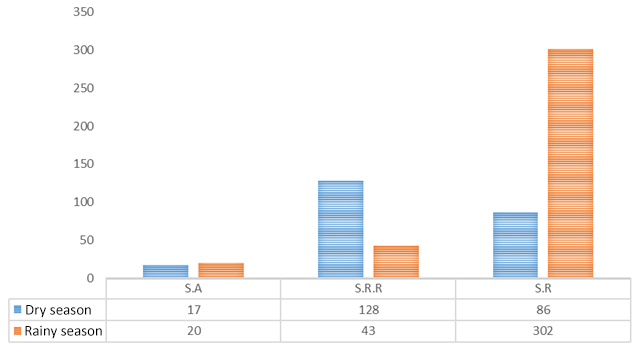
Figure 1. Relative abundance by benthic macrofauna sampling sites of soft substrates of the intertidal zone. S. A = Sitio Arenoso, S.R. R = Rocky Site Rio, S. R = Rocky Site.
Taxonomically, the individuals found were distributed in 4 Edges: Mollusca (n = 495), Annelida (n = 78), Arthropoda (n = 20) and Echinodermata (n = 3) (Figure 2). When analyzing the richness of species, it was observed that for the two seasons the S.A site presented the lowest values among all sampling sites with 8 and 11 species, respectively. The S.R.R site presented intermediate values compared to the other sites, but decreased its wealth from 21 species in the dry season to 16 species in the rainy season. Finally, the S.R site was the one that had the highest number of species in both seasons of sampling, with 22 species in the dry season, and increasing to 37 species in the rainy season (Figure 3).
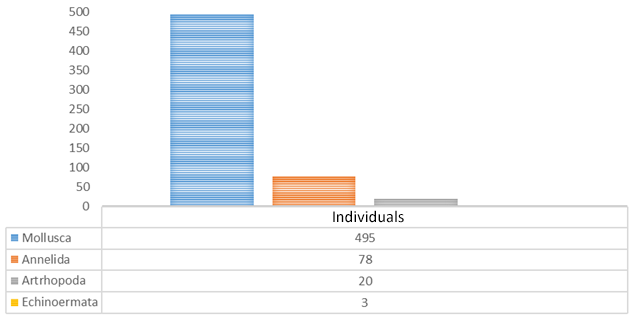
Figure 2. Phyllis abundance of benthic macrofauna of soft substrates of the intertidal zone.
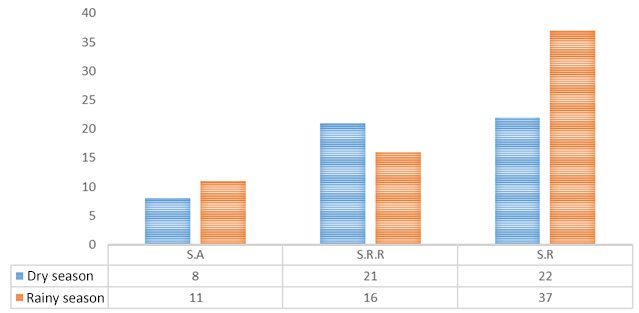
Figure 3. Richness of benthic macrofauna species of soft substrates of the intertidal zone. S. A = Sitio Arenoso, S.R. R = Rocky Site Rio, S. R = Rocky Site.
3.2. Shannon-Weaver Index
For the dry season it was found that in all sites the Shannon-Weaver index was less than 3.5 bits/ind. In the rainy season only S.R presented a value (2.72 bits/ind) close to the maximum indicative voltage (2.5 bits/ind) without exceeding it, due to the high number of species found (n = 302) (Figure 4). Regarding the dominance and equity of the species, changes in the behavior of the values were evidenced both between sites and between times of sampling, being the rainy season the one that had greater homogeneity (Figure 5).
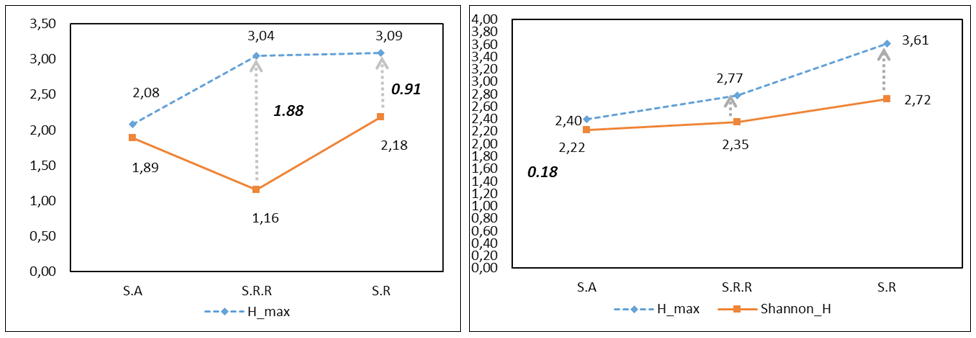
Figure 4. Shannon-Weaver index at sampling sites during the dry and rainy season.

Figure 5. Dominance and equity of species at sampling sites during the dry and rainy season
3.3. Physicochemical variables, granulometry and organic matter
The temperature ranged between 29.5 °C and 28.2 °C. The pH remained relatively stable between 8.13 and 8.06 during the dry season, but a minimum of 7.84 and a maximum of 8.04 showed little variation during the rainy season. The oxygen dissolved in the water had during both times with values that ranged between 0.2 mg.L-1 and 2.9 mg. L-1, only during the rainy season was an increase in the S.A site reaching 3.6 mg.L-1.
The percentage of oxygen saturation had variations between sites and times. The values during the dry season ranged from 4% to 54%; however, during the rainy season, the percentages increased and presented variations between them from 26% to 55%. The electrical conductivity was maintained with stable values at both times (43.3 mS.cm-1 - 55.8 mS.cm-1). Salinity ranged from 33 ups to 36 ups.
During the dry season, the BOD5 values ranged between 0.52mg.L-1 and 1.29mg.L-1, while in the rainy season the range values increased to 40 mg.L-1 and 70 mg.L-1. The COD, meanwhile, the range of values was between 7.51 mg.L-1 and 15 mg.L-1 during the dry season and the values were increased to 80.2 mg.L-1and 144.52 mg.L-1 in the rainy season. The organic matter content at both times of sampling was very low with values that did not exceed the detection limit. The maximum value of organic matter detected was 0.465%. Regarding textural characterization, all sites were classified as 100% sandy.
3.4. Identification of spatio-temporal distribution patterns
The results obtained reflected low similarity between sampling sites given by the number of species shared between sites (Table 1). In both epochs of sampling the species were distributed in different groups according to their abundance, being that for both periods there were five main groupings with differences between species of 80% during the dry season and 70% in the rainy season (Figure 6). When modeling the distribution of the benthic macrofauna individuals found at different times and sampling sites, a trend was found in the spatial distribution patterns of the individuals and not with the temporal distribution patterns. The model allowed us to recognize the decreasing trend in the density of individuals as they approached sites that provided an unprotected environment, this behavior was similar in both periods (Figure 7).
Table 1. Index of Jaccard (qualitative) and Morisita-Horn (quantitative) in both epochs of sampling - Pochomil Beach
|
Dry season |
|||||
|
Sites |
Number of species |
Abundance |
Samples compared |
Jaccard |
Morisita-Horn |
|
S.A |
8 |
17 |
1 y 3 |
0.2 |
0.123 |
|
S.R.R |
21 |
128 |
1 y 2 |
0.036 |
0.001 |
|
S.R |
22 |
86 |
2 y 3 |
0.229 |
0.028 |
|
Rainy season |
|||||
|
Sites |
Number of species |
Abundance |
Samples compared |
Jaccard |
Morisita-Horn |
|
S.A |
11 |
20 |
1 y 3 |
0.091 |
0.064 |
|
S.R.R |
16 |
43 |
1 y 2 |
0.227 |
0.601 |
|
S.R |
37 |
302 |
2 y 3 |
0.293 |
0.411 |
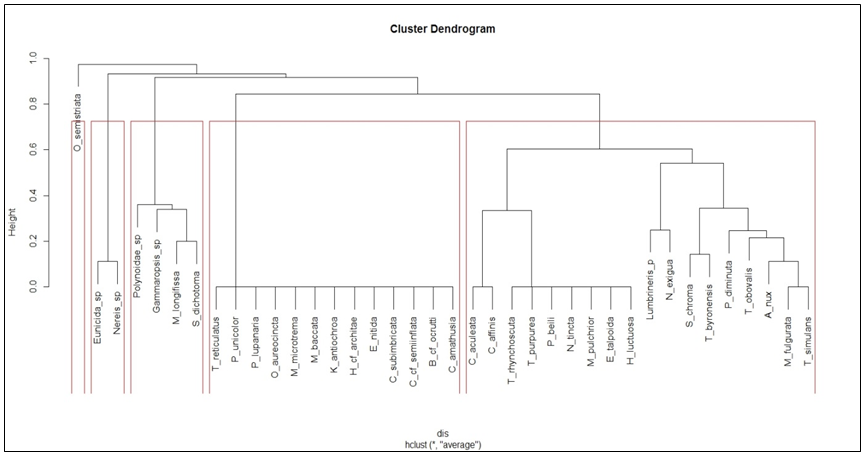
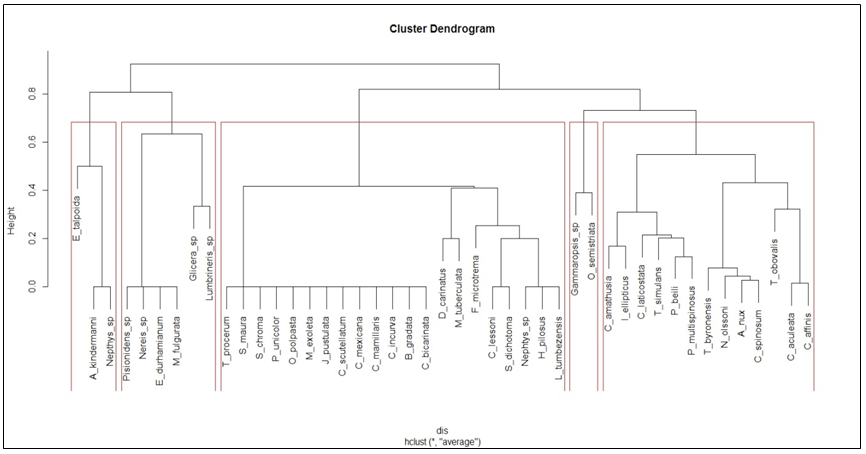
Figure 6. Species distribution dendrogram at all sites during the dry and rainy season.
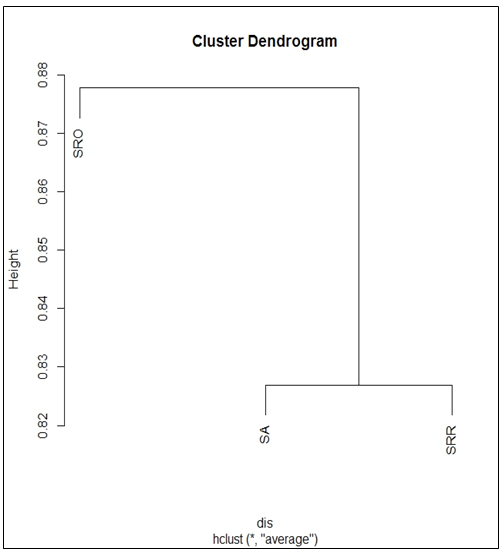
Figure 7. Dendrogram of similarities between sampling sites.
The values of the distribution of total density, during the dry season the values were around 130 ind.m-2, thus making it the time with the lowest density of benthic macrofauna. The SRR and SR sites concentrated the highest density values (130 ind.m-2 ± 100 ind.m-2) while SA had the lowest values (90 ind.m-2 ± 20 ind.m-2) . In the case of the rainy season, the total density increased 310 ind.m-2 at the S.R site and then gradually decreased (180 ind.m-2 ± 110 ind.m-2) towards the most unprotected intertidal zone (SA, 90 ind.m-2 ± 30 ind.m-2) (Figure 8).
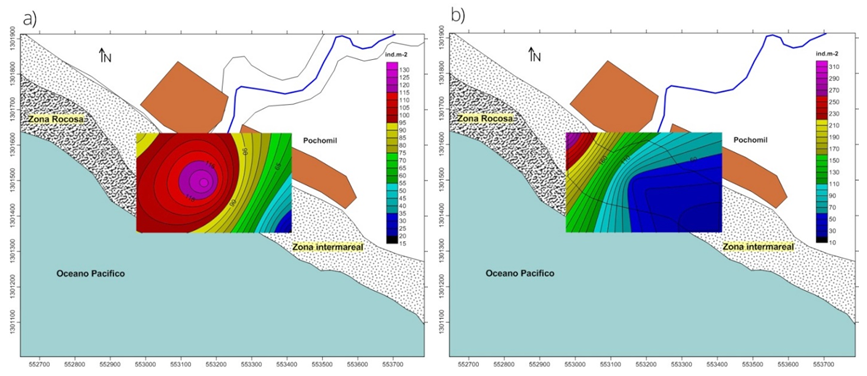
Figure 8. Distribution of the total density of benthic macrofauna of soft substrates of the intertidal zone - Pochomil Beach. a) Dry season b) Rainy season.
In Molusca Edge (Bivalva Class and Gastropod Class), the densities of individuals in both periods were concentrated in the S.R.R (130 ind.m-2) and S.R (300 ind.m-2) sites (Figure 9). The Annelid Edge (Polychaete Class), during the dry season the maximum density (60 ind.m-2) was concentrated in the sites without freshwater intrusion and greater protection area (SR), gradually decreasing towards unprotected areas (0 ind.m-2 ± 4 ind.m-2) (Figure 10). On the contrary, it was shown that the distribution of annelids during the rainy season decreased (9.5 ind.m-2 ± 2 ind.m-2) as they approached areas protected by the rocky system, the distribution of the Arthropod Edge (Subfilo Crustacea) (Figure 11) was characterized during the dry season for having the highest concentration at the S.A site (5 ind. -m-2). In the case of the rainy season, the highest densities were at the S.R.R site (10 ind.m-2) and decreased towards the S.R and S.A sites (7 ind.m-2 ± 0 ind.m-2). , the Equinodermata Edge presented the lowest density of all taxonomic groups, with 3 ind.m-2 and only had a presence in the dry and exclusive season In the sandy site (S.A) (Figure 12).

Figure 9. Distribution of the Molluscan Edge in the intertidal zone - Pochomil Beach. a) Dry season b) Rainy season.
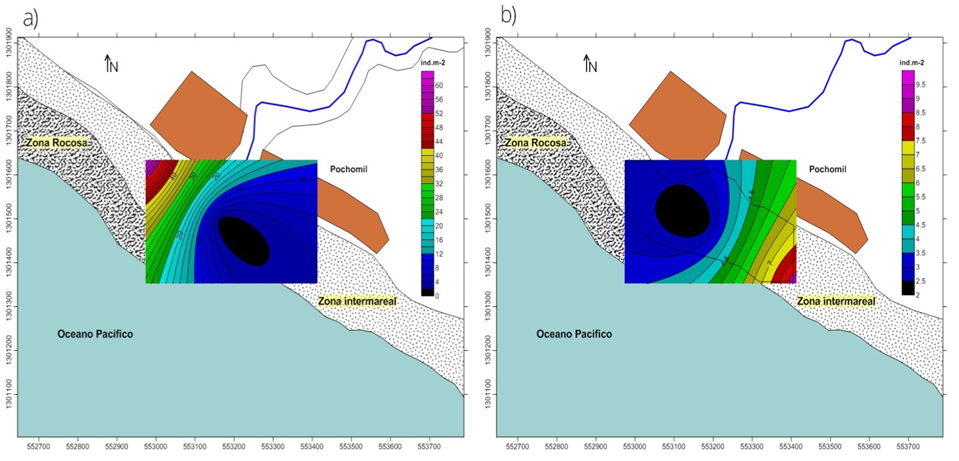
Figure 10. Distribution of the Annelida Edge in the intertidal zone - Pochomil Beach. a) Dry season b) Rainy season.
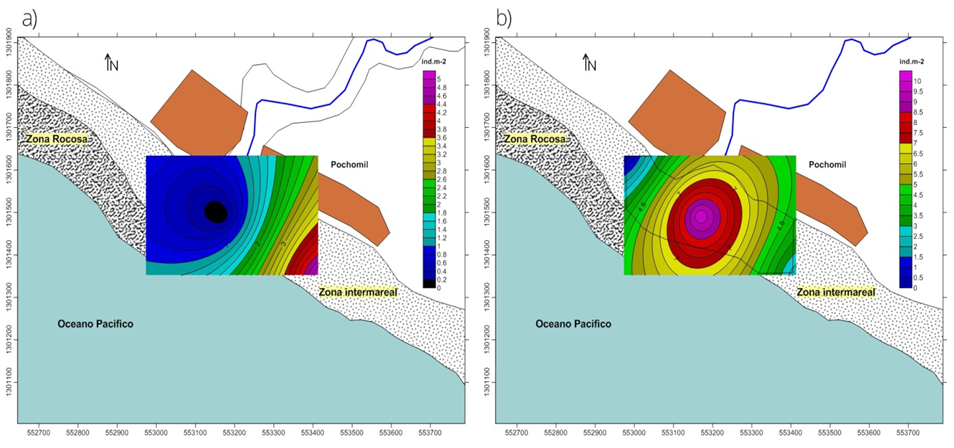
Figure 11. Distribution of the Arthropod Edge in the intertidal zone - Pochomil Beach. a) Dry season b) Rainy season
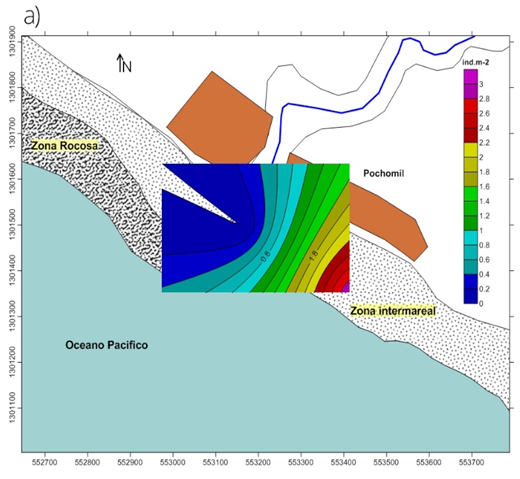
Figure 12. Distribution of the Equinodermata Edge in the intertidal zone - Pochomil Beach. a) Dry season
4. Discussion
According to Rodil and Lastra (2004) and Rodil et al. (2007) The macrofauna community in terms of abundance and richness of species, is more complex and diverse in protected rocky areas than in the exposed sandy beaches. In the intertidal zone of the Pochomil Beach, it was observed that those sampling sites that presented some type of protection from the direct action of the waves (S.R.R and S.R) had greater presence of individuals, while the unprotected site (S.A) showed the lowest values in the number of individuals and did not have a significant temporal variation of individuals. According to Escrivá (2013), some organisms are demanding with environmental requirements and it is common to find zoning in macrofauna communities; in the case of the S.R.R site there were variations for both abundance and richness of species. The above could be related to the physical conditions of the study site; Although the S.R.R site has a small rocky system that protects it, there is also a space of convergence between the sea and the Pochomil River where fresh water flows, which can modify the spatio-temporal distribution of individuals who have been previously exposed by Escrivá (2013). During the rainy season, the contribution of fresh water and sediment trawling probably influenced the mobilization or death of individuals due to the intolerance that some have to changes in the physical-chemical composition of the substrate. The latter coincides with that expressed by Pech and Ardisson (2010), who assure that changes in salinity due to the balance of freshwater and salt water contributions constitute a potential source of disturbance in the benthic community.
According to Álvarez and Pérez (2007), values below 2.4-2.5 bits/ind are indicative that the ecosystem is under tension. In the results obtained in the Shannon-Weaver index, the differences between the values of diversity between sampling periods are notable and it should be noted that, in congruence with the abundance and richness of species, the rainy season showed values closer to the maximum expected diversity (H_max).
Under normal temperature conditions Tait (1971) states that this variable is a controller of aspects of distribution of the species which are related to several basic processes such as growth, feeding and reproduction. Under extreme weather conditions, extremes of heat or cold can have devastating effects on the marine population, especially on coastal organisms; In the results obtained in the present investigation there were no significant variations in water temperature, thus reducing the possibility of this environmental variable playing a decisive role in the distribution of the macro-benthic organisms studied. According to Vega (1971), the variations in seawater pH are very small, with values usually between 8.1 and 8.3 and rarely values below 7.5 or above 9.0, which is consistent with the results obtained in the present study. The variables that had the greatest differences between periods were the BOD5 and the COD, which could be caused by the dragging of organic material produced by the rains, and that had a significant effect on the study area.
The distribution patterns of the coastal macrofauna have served as a basic tool for the identification and delimitation of defined biogeographic areas, so, the evaluation of marine communities, is based mainly on ecological studies that allow determining the integral species, in addition to shedding valuable information on the structure of rich and abundant populations that cohabit in a given area (Fernández et al., 2014). The distribution of the Mollusca Edge was mostly concentrated in those areas where the beach had more protected physical conditions. In addition, during the dry season it is notable that this taxonomic group preferred to be distributed in the area where there was a supply of fresh water, probably as a measure of survival against desiccation during low tide, which demonstrates the adaptability that these organisms possess in environments with conditions of extreme variability. According to Escrivá (2013) polychaete worms can be the dominant macrofauna in relatively protected sands and as hydro-dynamism increases and sediment becomes thicker, they tend to disappear due to direct wave action and desiccation during tide low, product of prolonged exposure to sunlight. For the Annelida Edge, the distribution of individuals during the rainy season decreased (9.5 ind.m-2 ± 2 ind.m-2) as they approached areas protected by the rocky system; this difference in the behavior of spatio-temporal distribution could be caused by the ability of species to adapt. During the dry season the species found were only Nereis sp. and an individual from the Polinoidae Family, while in the rainy seasonLumbrineris sp, Glycera sp., Nereis sp. and Pisionidens sp.
5. Conclusions
During the investigation period, in the intertidal zone of Pochomil Beach, 596 individuals of benthic macrofauna with soft substrates distributed in four edges (Mollusca, Annelida, Arthropoda and Echinodermata) were counted. The diversity of soft substrate benthic macrofauna calculated using the Shannon-Weaver index reflects very low diversity values for the dry and rainy season. It was evidenced that the temporality had no significant direct effect on the abundance and distribution of the soft substrate benthic macrofauna, and that it was the physical characteristics of the sampling sites that had direct influence. Through the Jaccard and Morisita-Horn index, it was shown that the sites showed low species similarity.
Aknowledgements
The authors thank the Postgraduate Directorate of the Universidad National Autónoma de Nicaragua (UNAN-Managua), who, through the Research Projects Fund, financed this research.
References
Álvarez, S. y Pérez, L. 2007. Evaluación de la calidad de agua mediante la utilización de macroinvertebrados acuáticos en la subcuenca de Yeguare, Honduras. Retrieved from http://bdigital.zamorano.edu/bitstream/11036/524/1/T2516.pdf
Bates, D., Bolker, B., Mächler, M. y Walker, S. 2015. Fitting Linear Mixed-Effects Models Using Ime4. Journal of Statistical Software. 67. Retrieved from https://www.jstatsoft.org/article/view/.../v67i01.pdf
Brusca, R. 1973. A Handbook to the Common Invertebrates of the Gulf of California. The University of Arizona Press: 427.
Carrasco, F. 1997. Organismos del bentos marino sub-litoral: algunos aspectos sobre abundancia y distribución en Biología Marina y Oceanografía: Conceptos y Procesos Tomo I Autor: Camilo Werlinger I. 315-332. Retrieved from http://biblio3.url.edu.gt/Publi/Libros/2013/BioMarina/11.pdf
Escrivá, P.J. 2013. Distribución y abundancia de macrofauna bentónica del infralitoral somero. Universidad Politécnica de Valencia. Gandia, España. 13-19. Retrieved from https://riunet.upv.es/bitstream/handle/10251/32845/Memoria.pdf
Fernández, J., Jiménez, M. y Allen, T. 2014. Diversidad, abundancia y distribución de la macrofauna bentónica de las costas rocosas al norte del Estado de Sucre, Venezuela. Biología Tropical 62: 947-956.
Gage, J.D. 2001. Macrobenthos en Encyclopedia of Ocean Science, 3: 1505-1515. Scottish Association for Marine Science, Oban, United Kingdom.
Gray, J. 1981. The Ecology of Marine Sediments: An introduction to the Structure and Function of benthic communities. Cambride Studies in Modern Biology 2. Cambridge University Press, USA.
Instituto Nicaragüense de Fomento Municipal (n.d). Ficha Técnica Municipal de San Rafael del Sur, Departamento de Mangua. Retrieved from www.inifom.gob.ni/municipios/.../managua/san_rafael_del_sur.pdf
Méndez, N., Sous-Weiss, V. y Carranza-Edwards, A. 1985. La importancia de la granulometría en la distribución de organismos bentónicos. Estudio de playas del Estado de Veracruz, México. Anales del Centro de Ciencias del Mar y Limnología. Universidad Nacional Autónoma de México (UNAM). Retrieved from http://biblioweb.tic.unam.mx/cienciasdelmar/instituto/1986-3/articulo240.html
Molina, O.A, y Vargas, J.A. 1994. Poliquetos (Annelida: Polychaeta) del estero de Jaltepeque, El Salvador una comparación 1959-1991. Biología Tropical, 43: 195-205. Retrieved from http://www.ots.ac.cr/rbt/attachments/volumes/vol43-1/19_Molina_Poliquetos.pdf
Monserrate, L., Medina, J. y Calle, P. 2011. Estudio de condiciones físicas, químicas y biológicas en la zona intermareal de dos sectores del Estero Salado con diferente desarrollo urbano. Guayaquil, Ecuador. Retrieved from https://www.dspace.espol.edu.ec/handle/123456789/19123
Oksanen, J. 2015. Multivariate Analysis of Ecological Communities in R: vegan tutorial. Retrieved from https://www.cc.oulu.fi/~jarioksa/opetus/metodi/vegantutor.pdf
Pech, D. y Ardisson, L. 2010. Biodiversidad y Desarrollo Humano en Yucatán. Ecosistemas y comunidades. Comunidades acuáticas: Diversidad en el bentos marino-costero; 145.
R Development core Team. 2015. R: The R Project for Statistical Computing. Retrieved from https://www.r-project.org/
Rodil, I. and Lastra, M. 2004. Environmental factors affecting benthic macrofauna along a gradient of intermediate sandy beaches in northern Spain. Estuarine and Coastal Shelf Science 61: 37-44.
Rodil, I.F., Lastra, M. y López, J. 2007. Macroinfauna community structure and biochemical composition of sedimentary organic matter along a gradient of wave exposure in sandy beaches (NW Spain). Hydrobiologia 579: 301-316.
Rodríguez, J.J. y Windevoxhel, N. 1993. Análisis regional de la situación de la zona costera centroamericana. Banco Interamericano de Desarrollo (BID). Washington D.C. Retrieved from http://publications.iadb.org/handle/11319/4666?locale-attribute=es
Tait, R.V. 1971. Elementos de ecología marina. Editorial Acribia, Zaragoza, España.
Tarazona, J., Paredes, C. y Igreda, M. 1986. Estructura del macrobentos en las playas arenosas de la zona de Lima, Perú. Instituto de Investigaciones de Ciencias Biológicas Antonio Raimondi, Facultad de Ciencias Biológicas, Universidad Nacional Mayor de San Marcos. Revista de Ciencias U.N.M.S.M. 74: 102-116. Retrieved from http://sisbib.unmsm.edu.pe/bibvirtualdata/publicaciones/rev_ciencias/v74_n1/a11.pdf
Vega, M. 1971. Introducción a la ecología de los bentos marinos. Departamento de Pesquería. Universidad Nacional Agraria, Perú.
Villalaz, J., Vega, C., Ávila, Y. y Gómez, J. 2002. Análisis temporal de macroinvertebrados bentónicos en playa El Agallito, Chitré. Tecnociencia 4: 111-126. Departamento de Biología Marina y Limnología. Universidad de Panamá. Retrieved from http://www.up.ac.pa/ftp/2010/f_ciencias/tecnociencias/volumen4-2/articulo10.pdf
Villamar, F. 2013. Estudio de los poliquetos (gusanos marinos) en la zona intermareal y submareal de la Bahía de Manta (Ecuador), y su relación con algunos factores ambientales, durante marzo y agosto del 2011. Acta Oceanográfica del Pacífico 18. Retrieved from www.inocar.mil.ec/web/phocadownloadpap/actas.../OCE1801_11.pdf